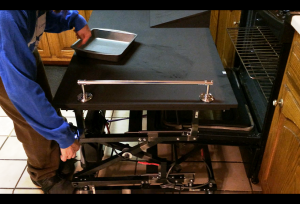Designers: Timothy Yang, Fred Shen, Ishi Singh, Andrew Yuan
Client Coordinator: Debbie Thorpe, PT
Supervising Professor: Larry Bohs
INTRODUCTION
Moving heavy dishes from the oven to counter is difficult for our client, who has hemiplegia. The Oven-to-Counter Cart combines a scissors-based structure with a commercial car jack and battery to enable users to automatically raise and lower the tabletop to either counter or table height. With the cart, the client can safely move heavy and hot casseroles, allowing her more independence in the kitchen.
SUMMARY OF IMPACT
The Oven-to-Counter Cart allows the client to make large hot dishes, which she had previously been unable to do.
Now she can entertain guests independently.
TECHNICAL DESCRIPTION
The Oven-to-Counter Cart (Fig. 1) is comprised of a top with ramp and handle, support structure, car jack, battery pack and casters. The 27×42” cart top is constructed from ½” plywood, painted with temperature-resistant black paint. A 11x13x4” tall plywood ramp allows the client to quickly move dishes from the counter to cart without adjusting the cart height. A 20” long handle (Threshold brand towel bar) attached to one edge of the cart top makes it easy for her to move the cart into place.
The support structure includes a top and bottom frame, scissor legs, drawer slides, and cross supports. The 40x25x4” tall top frame is constructed from sections of 1” aluminum tubing, connected with L-brackets and screws. The similarly constructed bottom frame is 2 ½” tall, and includes 4” stop posts that prevent the cart from lowering below the height of the opened oven door. Four 10”-long ball-bearing drawer slides (Sugatsune) attach to both sides of the top and bottom frames, providing mobility for the scissor legs. Wooden cross supports, 37” long and made from 1×2” hardwood painted black, attach between the drawer slides on opposite sides of the cart, forcing the slides to move in unison.
The scissor legs are made from 22” lengths of 1” square aluminum tubing, connected in the middle with a shoulder bolt to provide a pivot point. The scissor legs transfer the horizontal motion of the car jack into vertical motion of the cart top. Four cross supports, made from 37” long, 5/8” diameter steel rod, connect between the ends of the scissor legs on opposite sides of the cart for structural support.
A 12V motorized car jack (Black Bull, 12V 2000lb) mechanizes the up/down motion of the cart top, using the jack’s handheld control switch The range of jack motion is calibrated to correspond to the desired height range of the cart. One end of the jack attaches to the front of the bottom frame. The other end connects to a 10×3” jack support, which attaches to the bottom front cross support, thereby transferring motion of the jack onto the scissor legs. The jack support is constructed from 1” aluminum tubing, reinforced with corner braces for rigidity.
A commercial jump-starter battery (Husky 300 amp) provides power for the car jack’s DC motor. The battery is easily recharged when the cart is not in use using the supplied AC/DC wall adapter. The small rotational switch on the jump-starter is modified for easier client use by adding an extension made of high-density polyethylene with a hole for her finger.
Locking 3” casters attach to the corners of the bottom frame, allowing the cart to be rolled easily between the kitchen and the dining room. The locking mechanism, actuated by the client using her foot, stabiles the cart in position while moving dishes between the cart and oven, counter, or dining room table.
Fig. 2 shows the client using the cart. Moving the cart from the lowest position at the oven to the highest at the counter takes approximately one minute. The cost of components is $320.

